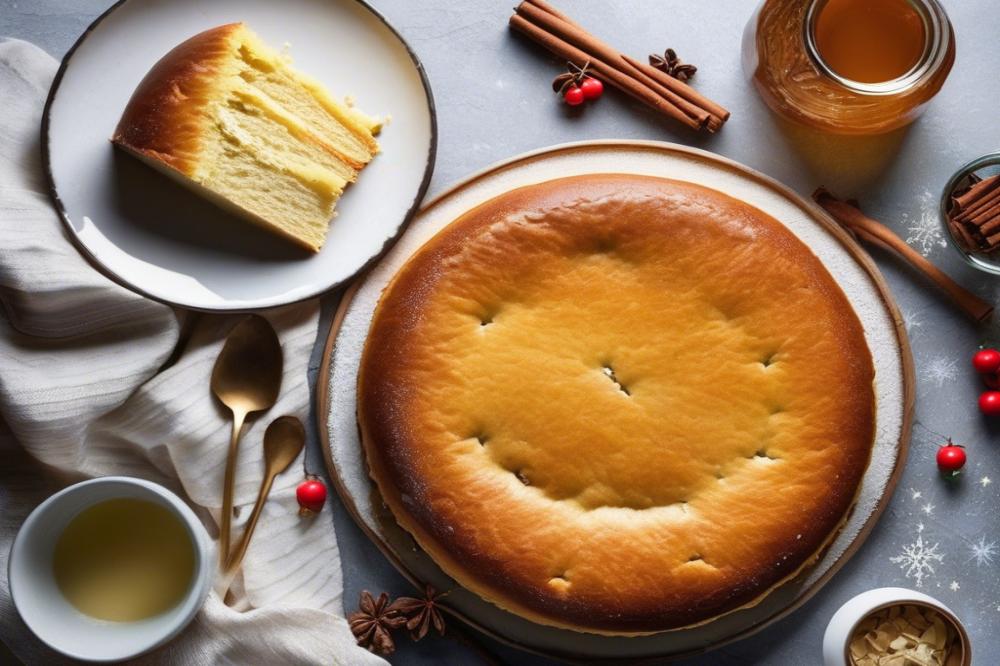Understanding Vasilopita and Its Traditions
The Vasilopita is a special Greek cake that holds a significant place in New Year’s traditions. Each year, families across Greece prepare this sweet treat to celebrate the arrival of another year. The cake symbolizes good luck and prosperity for the year ahead. Notably, the preparation of this dessert is not just about baking; it embodies a rich cultural heritage and spiritual blessings.
The history of Vasilopita is deeply connected to the Greek Orthodox Church. This cake is traditionally baked on New Year’s Eve to honor St. Basil, a beloved figure known for his generosity and charity. Families engage in a meaningful ritual of hiding a coin within the cake. The person who finds the coin is believed to receive blessings and good fortune in the coming year. This tradition strengthens the ties between family members and enhances the festive spirit of the occasion.
This article aims to guide you in making the perfect Greek New Year’s Cake. You will discover a classic baking recipe that captures the essence of this delightful dessert. The inclusion of citrus flavors adds a refreshing touch, making it a truly festive treat. Whether it’s for Kings Day or your own family celebration, preparing Vasilopita will make your New Year’s Eve memorable.
What is Vasilopita

The Greek cake known as Vasilopita holds a special place in the hearts of many. Traditionally baked on New Year’s Day, this dessert represents the beginning of a new year. Families come together to celebrate and share in the joy of this festive occasion. A typical Vasilopita has a delightful citrus flavor, making it a refreshing treat during the winter months.
Symbolism plays an essential role in the significance of this cake. Inside, a coin is hidden, and whoever finds it is believed to have good luck for the entire year. This coin hiding tradition adds an element of excitement and surprise to the celebrations. Each slice cut from the cake shares not just a taste but also the potential for prosperity and blessing, making it a cherished ritual among families.
During Kings Day, also known as Epiphany, Vasilopita serves as a connection to Greek Orthodox beliefs. It is a way to honor Saint Basil, whose feast day is celebrated on January 1. The cake’s role in these festivities goes beyond mere dessert; it symbolizes gratitude and remembrance. As people gather around the table, they partake in the spirit of generosity and community embraced by the New Year’s traditions.
This celebration cake also brings families closer together. As they gather on New Year’s Eve, the act of sharing the cake promotes unity and joy. The festive nature of the Vasilopita enhances the atmosphere, marking the occasion with sweetness and love. In this way, it serves as both a culinary delight and a centerpiece of celebration for many Greek households.
Ingredients and Nutritional Information

For a traditional Greek cake enjoyed during New Year’s traditions, gather the following ingredients. Each component contributes to the festive spirit and flavors of the celebration.
- 4 cups all-purpose flour
- 1 cup sugar
- 1 cup unsalted butter, softened
- 4 large eggs
- 1 cup milk (or yogurt for a richer flavor)
- 1 tablespoon baking powder
- Zest of 1 orange and 1 lemon
- 1 teaspoon vanilla extract
- Pinch of salt
- Optional: powdered sugar for dusting
Now, let’s talk about the nutritional information for the main ingredients. Each slice of Vasilopita offers a delightful balance of calories, fat, carbohydrates, and proteins. Generally, one serving might contain around 350 calories. It could have about 18 grams of fat, alongside 40 grams of carbohydrates. Each piece typically provides around 6 grams of protein. Keep in mind that these numbers can vary based on specific brands and ingredient choices.
The use of fresh citrus zest is essential for enhancing flavor. The combination of orange and lemon provides a bright and refreshing taste. It elevates the cake’s overall profile, making it a standout festive dessert. Incorporating these zests adds a layer of aromatic joy that complements the other ingredients beautifully.
During Kings Day, this special baking recipe becomes significant. Hiding a coin in the cake represents good luck for the year ahead. The tradition fosters excitement and laughter as family members eagerly await the slice that may reveal that hidden surprise. This Greek Orthodox celebration cake not only symbolizes the New Year but also brings everyone together. Baking this cake is more than just about the flavors; it’s about creating lasting memories.
Baking Instructions

Start by preheating your oven to 350°F (175°C). This step is essential for achieving the perfect texture. During this time, you should prepare your cake pan. A round, 9-inch pan works well for this recipe. Grease the pan lightly with butter and dust it with flour. Before pouring the batter, hide a coin in the pan. Traditionally, the coin symbolizes prosperity and good fortune for the year ahead.
Next, cream together the softened butter and sugar in a large mixing bowl. This process creates a light and fluffy base for your cake. Once smooth, add the eggs one at a time, mixing well after each addition. Incorporate milk, citrus zest, and vanilla extract into the mixture. These ingredients will add a refreshing flavor, making your dessert vibrant and aromatic.
Now, it’s time for the dry ingredients. Combine all-purpose flour, baking powder, and a pinch of salt in another bowl. Gradually mix this into your wet mixture. The goal is to blend everything until it’s just combined without overmixing. Take a moment to appreciate the lovely citrus aroma as it fills the air.
Pour the batter into your prepared cake pan. Use a spatula to evenly spread it out. Bake your cake for about 50-60 minutes. Keep an eye on it as it cooks. To check for doneness, insert a toothpick into the center. If it comes out clean or with just a few crumbs, your cake is ready. Once baked, let it cool in the pan for about 10 minutes. After that, gently transfer it to a wire rack to cool completely.
When it comes to serving, think of how to make your cake special. Dust the top with powdered sugar for a snowy effect. You can place a decorative plate underneath for an elegant touch. If you want, slice into the cake in front of friends and family, revealing the hidden coin. This moment ties beautifully to New Year’s traditions, especially on Kings Day. Sharing the cake symbolizes hopes for a happy and prosperous year.
Vasilopita can be enjoyed plain, but it’s also delightful when served with a dollop of whipped cream or a scoop of vanilla ice cream. This festive dessert brings joy to any celebration, making it a fitting choice for your New Year’s Eve feast. Enjoy the flavors and the company as you celebrate a new beginning.
Traditions and Variations

Across Greece, the New Year’s cake comes in many forms. Each region has its own way of making this festive dessert. For instance, in some areas, families prefer a lighter cake that contains more citrus zest. Others favor a denser, richer version with extra eggs and butter. This flexibility in the baking recipe allows people to adopt flavors that match their local tastes.
In the diaspora, these traditions still thrive. Greek communities around the world celebrate with their own adaptations. In the United States, for example, some families might include popular American ingredients, such as chocolate chips or cream cheese frosting. These small changes reflect how culture influences recipes over time.
Family Customs
Every family has unique customs when it comes to this New Year’s tradition. Some gather to bake the cake together on New Year’s Eve. Others choose to make it a solo activity, letting the baker add their personal touch. The meaning of the cake also varies. Many families keep a coin hidden inside, a practice called “coin hiding.” This symbolizes good luck for the year ahead, and the person who finds it is thought to be especially blessed.
Furthermore, each slice is often dedicated to a specific person. The first piece usually goes to Christ, followed by the home, then to family members and friends. This sharing creates a heartwarming sense of community during the celebration.
Personalization Ideas
Personalizing the cake can be an enjoyable process. Adding nuts, such as almonds or walnuts, adds texture and flavor to the cake. Dried fruit like raisins or cranberries can also give it a wonderful sweetness. Some even mix in spices like cinnamon or vanilla for a warmer taste. Different icing or toppings can change the cake’s appearance. A sprinkle of powdered sugar can make it look festive, while a glaze can provide a shiny finish.
Citrus flavors remain popular, too. A hint of orange or lemon zest can brighten up the cake. These variations allow each family to create a version that feels perfect for their celebration. Every bite becomes a reminder of the customs passed down through generations.
Celebrating New Year’s Eve with Vasilopita
The Greek cake holds a special place in New Year’s traditions. Families gather to celebrate not only the new year but also their shared heritage. The act of baking this festive dessert often starts a few days before the celebration. Citrus flavor fills the kitchen, creating anticipation for the big night.
As the evening approaches, homes come alive with laughter and stories. Friends and family unite around the table. The cake is more than just a tasty treat; it symbolizes unity and hope. Each bite connects people to their culture and to one another, reinforcing bonds that support them throughout the year.
A unique moment occurs when it’s time to cut the cake. This ceremony is filled with excitement and anticipation. Traditionally, a coin is hidden inside the cake, bringing blessings to the person who finds it. This practice creates a sense of luck and joy, reminding everyone of the promise of new beginnings.
Following the cutting, each slice is carefully distributed. A portion is often set aside for the home and for those who have passed. This act reflects respect and gratitude. Each family member holds their breath, hoping to be the lucky one who receives the coveted slice containing the coin.
Through the joyful gathering and the sharing of this celebration cake, the essence of Greek Orthodox culture shines. The night becomes a memorable occasion. Participants express their wishes for prosperity and happiness in the year to come. It’s a day filled with hope and anticipation, as well as connections that make it special.
Wrapping Up the Celebration
Baking Vasilopita holds a special place in Greek culture. This delectable cake symbolizes the blessings of the New Year. Families gather together to honor their traditions as they slice into this sweet treat. The hidden coin inside embodies good fortune for the year ahead. It serves as a reminder of the importance of family and friends in our lives.
Trying your hand at this cherished recipe is an opportunity to participate in centuries-old traditions. By making and sharing this Greek cake, you connect with the heart of the celebrations. It’s a wonderful way to learn about the customs that have shaped generations. Each bite carries a story of hope and prosperity that has delighted people over time.
As you savor each piece of Vasilopita, remember the joy it brings. Enjoy the company of your loved ones during the New Year festivities. Celebrations are often sweeter when shared. Let this cake be a part of your New Year’s traditions, gathering family and friends around a table full of love and laughter.



